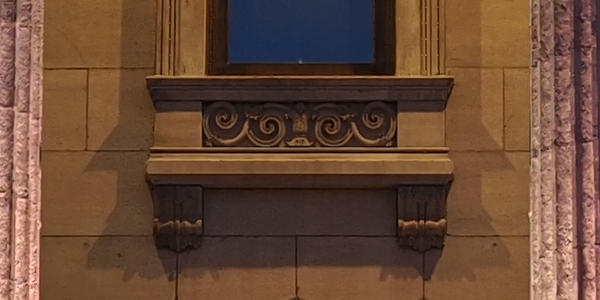Olympus OM-D E-M1X Review
Olympus OM-D E-M1X Introduction
The Olympus OM-D E-M1X is a unique mirrorless digital camera that takes the Micro Four-Thirds platform in a new and entirely unexpected direction: Professional Action Photography. This requires a really fast digital camera that can shoot high-speed bursts that can be sustained over long periods. Digital cameras specifically designed for this purpose tend to be quite large which makes it unusual for a mirrorless system and a surprising choice considering that Four-Thirds sensors are among the smallest for Interchangeable Lens Cameras. The E-M1X launched as the first dual-grip mirrorless, although the Medium Format Fujifilm GFX 100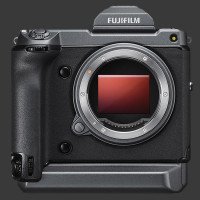
Fujifilm GFX 100 also features dual-grips.
A 20 megapixels Four-Thirds CMOS sensor with a builtin 121-Point Phase-Detect AF system that makes its debut on the E-M1 Mark II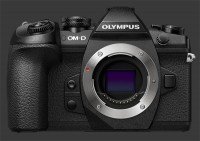
Olympus OM-D E-M1 Mark II is now paired with Dual TruePic VIII Quad-Core processors that allow the E-M1X to reach unprecedented speeds. It can capture 20 MP JPEG images or RAW files at an incredible 60 FPS with AF locked. When Continuous AF is enabled, it can shoot a class-leading 18 FPS using the electronic-shutter or 15 FPS with a mechanical one.
Olympus created the most powerfull image stabilization system in the world for the E-M1X. This 5-axis in-body image-stabilization system can compensate for 7-stops over hand-held photography with any lens and even 7½-stops when combined with an optically-stabilized lens. It manages to push ahead of the previous 6.5-stop limit by using a builtin GPS and Digital Compass to calculate how to compensate for the rotation of the Earth!
The E-M1X sports an ultra-durable hybrid-shutter that covers shutter-speeds of 1/32000 to 60s plus Bulb exposures of up to 3 hours. This professional mirrorless carries over all features of the previous OM-D flagship, including the innovative Live-Bulb and Live-Time modes. Bracketing for many parameters and Focus Stacking are all part of the extensive feature-set offered by this mirrorless. Video capabilities are also extensive with support for Cinema 4K at 24 FPS and Ultra-HD 4K at 30 FPS, plus Full HD at 120 FPS and Time-Lapse up to 4K Ultra HD resolutions.
As a high-end digital camera, the Olympus OM-D E-M1X is extremely rugged. Its body with fully weatherproof with an IPX1 rating, dustproof and freezeproof to temperatures of -10C. The camera offers twice dual control-dials, two 8-way focus-joystik and a high number of external controls, including EC, ISO and AE-L/AF-L which are replicated on each grip. The E-M1X fits Dual SDXC UHS-II memory-card slots and even dual-batteries for a battery-life of 870 shots-per-charge.
This Olympus has the largest EVF outside of Medium-Format offerings with a class-leading 0.83X magnification for its 2.4 MP 0.5" EVF which shows 100% coverage and includes an essential Eye-Start Sensor. It has a 3" LCD with 1 megapixels mounted on a rotating hinge. Connectivity options abound with this mirrorless with support for a external lighting via a standard hot-shoe or sync-port, USB 3.0 Type-C, WiFi, wired remote and both stereo input and output.
This digital camera review covers the performance and image quality of the Olympus O-MD E-M1X.
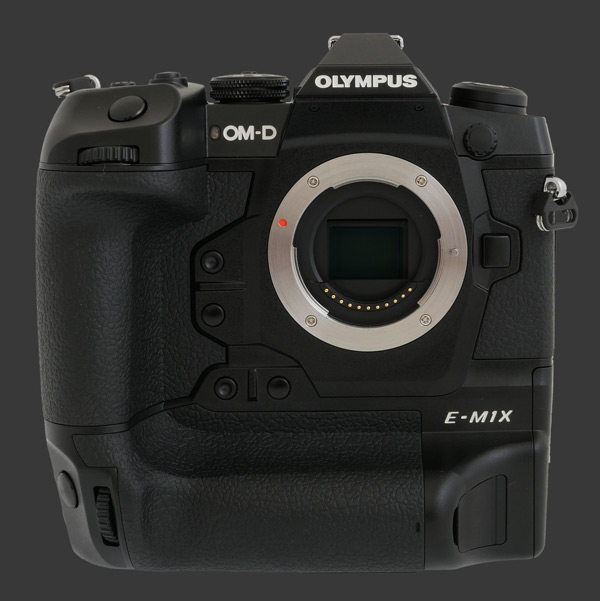
Olympus OM-D E-M1X Features
Sensor
- 20 Megapixels CMOS Four-Thirds sensor
- No Anti-Alias Filter
- Micro Four-Thirds lens mount
- Built-In Image Stabilization:
- 5-Axis Sensor-Shift
- 7-Stop Efficiency
- 7½-Stop Dual Stabilization
- Ultra-sonic dust-reduction
- High-Res Capture:
- 50 MP Tripod Mode: ISO 64-6400
- 50 MP Handheld Mode: ISO 64-1600
Exposure
- ISO 200 - 25600 range, 1, 1/2 or 1/3 EV steps
- Expanded ISO 64 - 25600 sensitivity range
- Auto ISO, custom limit 200 - 25600
- Hybrid Shutter:
- 1/8000 - 60s Mechanical Shutter-speeds
- 1/32000 - 60s Electronic Shutter-speeds
- 1/3, 1/2 or 1 EV Shutter-speed steps
- Bulb Exposure, max 3 hours
- PASM Exposure modes
- Program-Shift in P mode
- EC: ±5, 1/3, 1/2 or 1 EV increments
- Exposure-Shift, ±1, 1/6 EV increments
- Multi-Segment, Center-Weighed, Spot, Shadow Spot and Highlight Spot metering
- Auto-Exposure Bracketing: 3, 5 or 7 frames, max 1 EV steps except 1/2 EV for 7 frames
- Auto HDR Bracketing: 3,5 or 7 Frames @ 2 or3 EV apart
- Built-in HDR: 2 blending levels
- Flash-Compensation, ±3, 1/3 or 1/2 EV steps
- Auto, Redeye, Forced, Off, Slow-Sync+Redeye, Slow-Sync, Rear-Sync and Manual flash modes
- Manual flash power between full and 1/64th power
- Remote-Control flash
Image Parameters
- AutomaticTwo types: Normal and Warm-preserving., 7 presetsSunny, Shade, Cloudy, Incandescent, Fluorescent, Underwater, Flash, Kelvin and Custom White-Balance, 4 memories
- 5 Color and 1 B&W Picture Modes
- White-balance fine-tuning along 2 axis in 15 steps
- Digital white-balance preview
- Adjustable Gradation, Automatic or 3 levels
- Adjustable Contrast, Sharpness and Saturation, 5 steps each
- Adjustable Tone Curve, 15 steps for highlights and shadows
- Optional High-ISO Noise-Reduction, 3 levels
- Optional Long-Shutter Noise-Reduction
- sRGB or Adobe RGB color space
Output Processing
- 4:3 Native aspect ratio
- 3:2, 16:9, 1:1 and 3:4 cropped aspect ratios
- JPEG, RAW, RAW+JPEG capture
- 4 JPEG Compression levels
- Optional Keystone Compensation, 2 axis
Focus
- Single-Shot (AF-S), Continuous (AF-C), Direct Manual-Focus (DMF), Manual Focus or Preset
- Focus Selection: All, 5x5 Point, 3x3-Point, Plus, Point, Area or Custom
- 121-point Phase-Detect plus Contrast-Detect AF
- Focus Bracketing, 3-999 Frames, 10 step sizes
- Optional Focus Stacking
- Optional Manual Focus-Assist, 5-14X
- Optional Face-Priority
- Optional Focus-Peaking
- Optional Face-Priority
- Optional Bulb focusing
- Optional AF-Assist lamp
- Optional AF Fine-Tuning
- Optionally reset lens focus to infinity
- Controllable focus-ring direction
Drive
- Electronic Shutter:
- 60 FPS: 49 JPEG or RAW. AF-S Only.
- 18 FPS: 89 JPEG or 74 RAW. AF-S or AF-C.
- Optional Pre-Buffering, Max 35 Frames
- Mechanical Shutter:
- 15 FPS: Max 132 JPEG or 103 RAW
- 10 FPS: Unlimited JPEG or Max 287 RAW
- 8.5 FPS Anti-Shock Drive
- Interval Timer, 1-999 frames, 1s-24h interval, 0-24h delay
- Multiple-Exposure, 2 frames, optional automatic gain and composition overlay
- Live-Composite mode
- Self-timer, 2s or 12s or Custom
- Custom Timer: 1-30s, 1-10 Frames, ½-3s Interval
- Anti-Shock & Silent Shutter-Delay: 0-30s
Video
- 4096x2160 @ 24 FPS Cinema 4K
- 3840x2160 @ 30 FPS Ultra-HD 4K
- 1920x1080 @ 120 FPS Video
- 4K Time-Lapse Video
- Quicktime H.264 Codec
- PASM video exposure modes
- Automatic and Art-Filter video modes
- Built-in Stereo microphone:
- ±10 Input Gain
- Optional Volume Limiter
- Optional Wind Noise-Reduction, 3 levels
- Stereo audio input mini-jack
- Stereo audio output mini-jack, 16 levels
- Video-only button and dial customizations
Display & Viewfinder
- 0.5" EVF:
- 2.4 Megapixels
- 0.83X Magnification
- 100% Coverage
- Eye-start sensor
- Digital-level, 2-Axis
- 3" Rotating LCD:
- 1 Megapixels
- 3:2 Aspect-Ratio
- Touchscreen
- Live-Bulb & Live-Time
- Optional Live-Histogram
- Adjustable brightness, 15 steps
- Adjustable color temperature, 15 steps
Controls
- Double Dual control-dials
- Double 8-Way joysticks
- Double EC, ISO and AE-L/AF-L buttons
- Traditional Mode-Dial, 4 custom modes
- Dual Shutter-Releases
- Dual Grips
- Customizable buttons
Connectivity
- Hot-Shoe
- Sync Port
- HDMI 4K output
- USB 3.0 Type-C
- Wired Remote port
- A/C Power input
Misc
- Splashproof (IPX1 Rating)
- Weatherproof
- Dustproof
- Freezeproof down to -10C
- Dual SDXC UHS-II memory-card slots
- Dual Lithium-Ion batteries
- Built-in WiFi
Olympus OM-D E-M1X Capability - What can it do?
With the OM-D E-M1X, Olympus yet again produced one of the most feature-rich digital cameras on the market. It offers every feature needed by professional photographers and videographers plus quite a few extras. Its 20 megapixels anti-alias-filter-free sensor captures enough details for moderately large prints. The ISO 200-25600, expandable to include ISO 64-100, is now standard for interchangeable lens digital cameras and sufficient for photography down to moderately low-light. This is extended further with a best-in-class 5-axis image-stabilization system effective to an unprecented 7-stops!
Take a look how sharp a handheld photo can be even at with a 2s exposure, then click on the ISO/Shutter-Speed pair below to see the compromises possible:
Extremely large prints are possible using Super-Resolution mode which produces a 50 megapixels image from 16 separate exposures with the sensor shifted in-between. This Olympus introduces a new Hand Held mode which combines images taken at the right position during normal camera shake and applies an algorithm to compensate for discrepencies between frames. The previously used method is now called Tripod mode and works by combining exposures offset by the sensor-shift mechanism. Handheld mode is limited to ISO 64-1600, while Tripod mode can use ISO 64-6400. Any motion in the scene may cause problems and there is a significant delay in capturing and producing the output though. Look at the comparative crops page to see the results.
Its class-leading 1/32000s to 60s shutter-speed range can freeze ultra-fast motion as well as capturing trails of light. Much longer exposures of up to 3 hours are now possible in Bulb mode. The E-M1X also features Live-Bulb and Live-Time modes which are unique to Olympus. These modes show the progression of an exposure at regular intervals which is immensely useful when taking pictures of fireworks and light painting when exposure is impossible to predict.
Experimentation is made easy with the E-M1X by its extensive bracketing options. AEB is possible for up to 7 frames, while ISO, WB and Flash can be bracketed for 3 frames. There is also a Focus-Bracketing function that can capture stacks of up to 999 with the focus shifted in uniform steps between shots. This is a task which is simply impossible to peform manually with any leve of accuracy. Images can then be assembled using Focus Stacking software or the camera can perform the stacking internally with up to 15 frames. Increment size can be set in 10 steps. Here is a 5-frame in-camera Focus-Stack:






The E-M1X offers several metering patterns: Multi-Segment, Center-Weighed, Spot, Highlight Spot and Shadow Spot. The last two options are exclusively to Olympus digital cameras. They work similarly to Spot metering expect using a highlight or shadow, respectively, to set the overall exposure. When not using an exposure-target, Highlight Spot is easier to use than traditional Spot since it is easier to guess what is a highlight than a mid tone. Every type of White-Balance is supported with Kelvin and Custom WB option for completeness. WB Fine-Tuning along 2 axis in 15 steps is available for further adjustments.
When the Olympus OM-D E-M1 Mark II
Olympus OM-D E-M1 Mark II launched the newest Olympus Four-Thirds sensor, it delivered a significant leap in continuous shooting speed. Now, the E-M1X has dual quad-core TruePic VIII processors to take fully advantage of this new sensor speed. Using an electronic-shutter, the E-M1X can capture full 20 megapixels images at a class-leading 60 FPS. This is too fast for the camera to autofocus and meter between each frame, so both remain locked at the first frame. At a speed of 18 FPS, continuous autofocus and metering between frames is possible. This is incredibly fast. When using the mechanical shutter, the camera can still manage 15 FPS which remains best-in-class.
These high burst rates produce a large volume of data which has to be buffered while waiting for files to be written. A huge amount of internal memory allows the Olympus OM-D E-M1X to shoot up to 49 frames at the full 60 FPS. At 18 FPS, the USH-II speeds supported by both memory-card slots can clear the data sufficiently fast that bursts of 89 JPEG or 74 RAW files are possible. At the 15 FPS maximum mechanical-shutter speed, it can handle 132 JPEG or 103 RAW.
Supporting this exceptional speed is a hybrid autofocus system that combines Phase-Detection and Contrast-Detection. This 121-point AF system makes focusing extremely quick and accurate. Since autofocus is performed on-sensor, a large number of focusing aids can be offered: Focus Assist, Focus Check and Focus Peaking. Autofocus is extremely flexible with Direct Manual Focus, Tracking AF and Face-Priority AF available. A new mode allows users to dial-in the focus-distance to Preset focus, either manually or with the assistance of the AF-system.
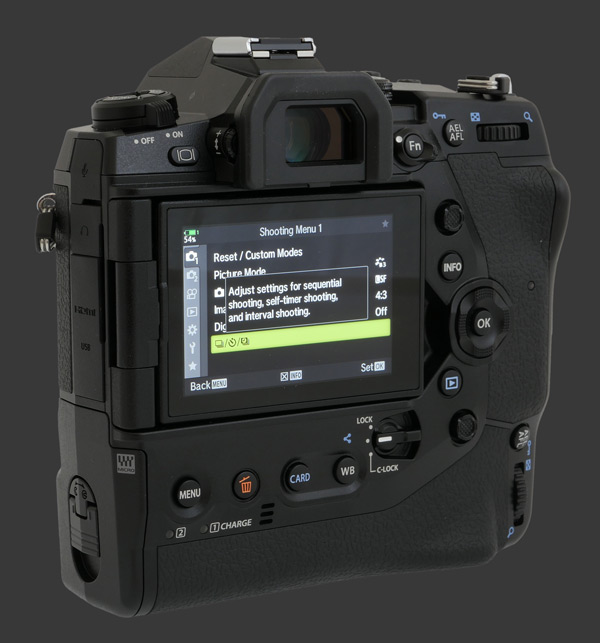
The Olympus OM-D E-M1X has quite possibly the longest list of Drive Modes available on any camera. The usual Single-Shot, Continuous and Self-Timers are all there, plus Interval Timer and Multiple Exposure. All modes are even customizable with Quiet and Anti-Shock versions These use an Electronic Front-Curtain Shutter (ECFS) or fully Electronic Shutter to minimize camera shake and noise, repectively. The Self-Timer is highly customizable. Several page of settings are devoted to continuous shooting modes. The Pro Capture mode adds pre-buffering up to 35 frames to virtually eliminate shutter-lag.
This mirrorless does not offer a built-in flash but supports external lighting via a standard hot-shoe and sync-port. An on-camera flash can be used as Wireless Commander for remote and multi-flash setups. Gone is the proprietary accessory-port with the E-M1X, giving a lower profile to the viewfinder hump. The built EVF itself is a 0.5" unit which shows 0.83X magnification and 100% coverage. It has an essential Eye-Start Sensor with just the right sensitivity and very short delay. The back of the camera features a rotating 3" touchscreen LCD that is more flexible than on its predecessor while appearing relatively durable.
Professional photographers are well-served by dual SDXC UHS-II memory-card slots that are extremely configurable. A second card may be used simply increase storage capacity, to separate files by type or create a real-time backup of images as they are captured. The only feature omitted from the dual-slot setup is that there is no way to delete images from both cards at once.
A high-speed sensor allows extensive video capabilities. For the E-M1X and E-M1 Mark II, this includes Cinema 4K and Ultra-HD 4K recording. The former captures 4096x2160 frames with a 17:9 aspect-ratio at 24 FPS, while the latter does 3840x2160 with a 16:9 aspect-ratio. It can be recorded at 30 or 24 FPS. Both 4K modes are stored at 100 Mbps in Quicktime format using the H.264 codec.Full HD is also supported at 24 to 120 FPS with but-rates of 18 to 202 Mbps, giving users plenty of control over compression, including All-Intra mode which improves video editing.
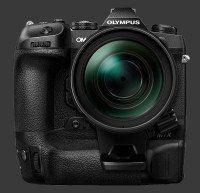 |
Please Support Neocamera
All information on Neocamera is provided free of charge yet running this website is a huge endeavor. Purchases made via affiliate links found throughout the site help keep it running and up-to-date. There is no additional cost to you, so please consider buying via these links to our affilates:
If you found any information on this site valuable and did not purchase via our affiliate links, please considering donating via PayPal:
Any amount will be greatly appreaciated. Thank you for your support!
Olympus E-M1X Highlights

Sensor-Size: 17 x 13mm

Actual size when viewed at 100 DPI
| 20 Megapixels Mirrorless | ISO 64-25600 |
| Micro Four-Thirds Mount 2X FLM | Shutter 1/32000-60s |
| 5-Axis Built-in Stabilization, 7-Stop Improvement | Full manual controls, including Manual Focus |
| 0.50" Built-in EVF 2.4 Megapixels (0.83X) | Custom white-balance with 2 axis fine-tuning |
| Automatic Eye-Start sensor | Spot-Metering |
| 2 Axis Digital Level | Hot-Shoe & Sync-Port |
| Weatherproof down to -10C | Stereo audio input |
| Built-in Dust Reduction | Lithium-Ion Battery |
| 60 FPS Drive, 49 Images | Secure Digital Extended Capacity x 2 |
| 4096x2160 @ 24 FPS Video Recording | |
| 3" LCD 1 Megapixels |
Updates
2025.01.18

Fujifilm GFX 2025 Lens Roundup
Lens Review roundup of Fujifilm GFX Medium-Format lenses. Quality, performance and handling of the GF20-35mm F/4R WR, GF30mm F/3.5 Tilt-Shift and the GF55mm F/1.7.
2024.11.18

Best 2024 Photography Gifts for Every Budget
Great gifts for photographers and photo enthusiasts selected for every budget among the best products of 2024.
2024.08.07

Eye Protection Tips for Professional Photographers
The four main considerations for professional photographers regarding eyewear.
2024.07.14

Fujifilm X100VI Review
Flagship fixed-lens compact digital camera with a 40 MP sensor and Image-Stabilization, a first for the series. Retro design featuring dual control-dials, plus direct ISO, Shutter-Speed and EC dials. Its hybrid viewfinder can switch between EVF and OVF mode.
2024.05.09

Fujifilm GFX100 II Review
Flagship 102 Megapixels Medium-Format Mirrorless Digital Camera with 8-Stop 5-Axis IBIS, 8 FPS Drive, 8K Video and 400 MP Super-Resolution capture in a weatherproof and freezeproof body with dual control-dials and dual memory-card slots.
2024.04.03

Fujifilm X-T5 Review
Newest Fujifilm flagship boasting a 40 MP APS-C sensor, 5-axis IBIS with 7-stop efficiency, 15 FPS continuous drive, 6.2K Video capture, dual control-dials and dual SDXC UHS-II slots in a sturdy weatherproof and freezeproof body.
2023.11.20

Best Digital Cameras of 2023
Find out which are the Best Digital Cameras of 2023. All the new Mirrorless Digital Cameras from entry-level to high-end professional.
2023.07.10

Fujifilm X-H2 Review
40 Megapixels APS-C Hybrid Mirrorless Digital Camera with 7-stop IBIS. Fastest shutter ever and 8K video capture. Large builtin EVF with 0.8X magnification and 5.8 MP, plus an Eye-Start Sensor. Packed with features and large number of controls in a weatherproof and freezeproof body.
2023.05.07

Sony FE 20-70mm F/4G Review
Review of the unique Sony FE 20-70mm F/4G lens. The optical zoom of this lens spans ultra-wide-angle and medium focal-length coverage, making it one of the most versatile Full-Frame lenses on the market.
2023.01.15

Huion Inspiroy Dial 2 Review
Review of the Huion Inspiroy Dial 2 tablet, a medium sized drawing surface with dual dials and customizable buttons. Connects via USB-C or Bluetooth 5.0 with Windows, Linux and Android support.
2022.12.08

How to Pack for a Photo Trip
Find out how to pack for a travel photography trip, carry your gear safely while meeting airline regulations.
2022.11.13

Best Digital Cameras of 2022
The best digital cameras of 2022. A short list of the most outstanding models in their respective categories. Choose one for yourself or as a gift.



